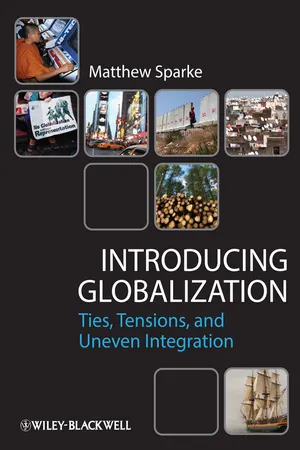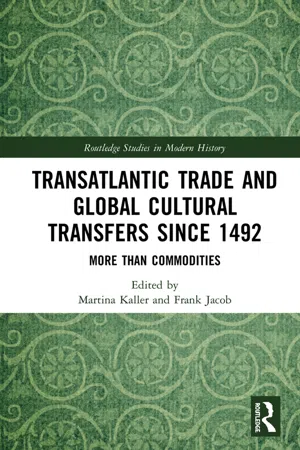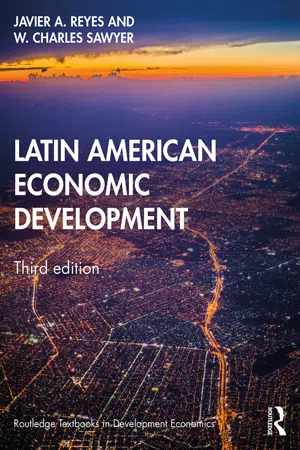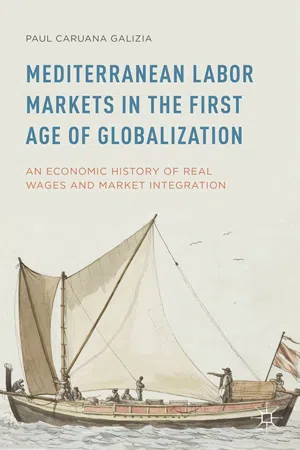History
Global Commodities
Global commodities refer to raw materials or goods that are traded internationally. Throughout history, commodities such as spices, silk, sugar, and coffee have played a significant role in shaping global trade, economies, and cultural exchange. The demand for these commodities has driven exploration, colonization, and the development of trade routes, impacting societies and economies worldwide.
Written by Perlego with AI-assistance
Related key terms
Related key terms
1 of 4
Related key terms
1 of 3
5 Key excerpts on "Global Commodities"
- eBook - ePub
Introducing Globalization
Ties, Tensions, and Uneven Integration
- Matthew Sparke(Author)
- 2012(Publication Date)
- Wiley-Blackwell(Publisher)
across international borders. Their transnational travels and ubiquity make such commodities the most taken for granted, telling, and yet troubling examples we have of economic globalization. Taken for granted, because, despite all the purchases that are made everyday in every part of the world, consumers rarely think about, let alone explore, where commodities come from. Telling, because once one does start to explore where commodities come from a whole world of interdependence starts to come into view. And troubling because this economic interdependence raises far-reaching ethical and political questions about our responsibilities as consumers, workers, and managers with ties to commodity production in foreign countries.The overall aim of this chapter is to introduce ways of deciphering the information about economic globalization provided by tracking commodities. It is worth remembering in this respect that key statistics used to measure commodity flows remain based on national data that are still gathered – as the root of the word stat istics reminds us – by states . While also collected and compared by global agencies such as the World Trade Organization (WTO), they are mainly counted by national state governments with a focus on national economic activities. Gross domestic product (GDP), for example, is normally calculated by adding up the value of all the finished goods and services produced within a particular national economy in a particular year. Likewise, trade data measure imports and exports into and out of particular national economies. As we shall see, the relationship between these two key commodity metrics – the ratio of trade to GDP – can tell us a great deal about changes in the degree of economic globalization over time. But, by the same token, today’s form of globalization is so intense and multilayered that it is also changing the meaning of the national statistics, too: making national GDP an inadequate tool for measuring and managing cross-border economic coordination; and sometimes overstating the ratio of trade to GDP because of how the latter does not include all the non-finished goods – the multiple components and intermediate products – that increasingly comprise such a big portion of cross-border commodity flows in the most globalized economies.1 - eBook - ePub
Commodity Politics
Contesting Responsibility in Cameroon
- Adam Sneyd, Steffi Hamann, Charis Enns, Lauren Q. Sneyd(Authors)
- 2022(Publication Date)
- McGill-Queen's University Press(Publisher)
Applying this approach to the topic at hand then, after the Second World War there was an attempt to build a consensus that the international commodity trade was primarily economic in nature. From this business-friendly viewpoint, politics, in the form of nationalizations or regulations, was typically portrayed as an intrusion into the economic sphere. Governments of the then so-called advanced industrialized states, and businesses with stakes in the production and movement of raw materials, reliably advanced this notion (Cox 1979). But much like many other apparent alignments of interest, that consensus was always more apparent than it was real. And it also depended on massive historical omissions. Looking at the production and movement of Global Commodities in historic perspective, politics and the exercise of power have in reality made incredible contributions to building and maintaining the global commodity trade. Slavery, for example, subsidized the growth of global trade in sugar and cotton for some time (Beckert 2014). Gunboat diplomacy was used to secure preferential imperial treaties and trade pacts (Chang 2009). Imperial powers also instigated wars, such as the Opium Wars, in part to correct their own balance of payments problems linked to the commodity trade. And direct and indirect colonization was used to impose commodity export specializations on many African places. Those impositions yielded asymmetrical trade relations that persist (Murphy 1984). The ongoing dependence of many of theUN -designated Least Developed Countries on the exports of basic extractive or agricultural commodities is indicative of these enduring political legacies ( UNCTAD 2017).From the early 1970s, many governments across the Global South stridently challenged the view that commodities should be considered solely economic goods. They sought to apply political pressure on commodity-importing countries in the Global North. Working individually and sometimes collectively, in many cases they aimed to set prices for a diverse range of export commodities at higher levels in order to generate increased foreign exchange earnings. Leaders across the Global South had been inspired by the notion advanced by Raúl Prebisch and Hans Singer that the persistence of commodity export models undercut the potential to transform their “peripheral” societies in relation to the “core” countries (Caldentey and Vernengo 2014; Margulis 2017). Other more critical scholars added fuel to the idea that the terms of the commodity trade were stacked against economic transformation in the 1970s. At that time, a politics of economic liberation shaped up most prominently in countries such as Chile and infused debates on trade and development at the United Nations General Assembly. Many policy and decision makers in the Global North characterized this movement as an effort to politicize the commodity trade. And while the inter-state, international movement ultimately foundered by the 1980s, the idea that there was such a thing as commodity politics continued to simmer in the background. - eBook - ePub
Transatlantic Trade and Global Cultural Transfers Since 1492
More than Commodities
- Martina Kaller, Frank Jacob, Martina Kaller, Frank Jacob(Authors)
- 2019(Publication Date)
- Routledge(Publisher)
Nevertheless, as US historian Roy Bin Wong correctly remarks, “[t]he world of production before 1800 was overwhelmingly agrarian.” 10 It is consequently not surprising that the increasing interest in the Atlantic as a specific geographic and economic space of study stimulated the production of numerous commodity histories, something US scholar Bruce Robbins describes as “a suddenly ubiquitous genre of popular nonfiction.” 11 He also highlights that the “titles [of the named popular historical works] suggest that all these commodities, even the humblest, have the power to get continents discovered, dynasties toppled, [or even] mountains moved.” 12 While popular historical writings about the commodity trade and its impact on and within the Atlantic World have become commodities themselves, it cannot be omitted that commodities like sugar, tobacco, chocolate, etc., played an important role in shaping not only the Atlantic, but the whole world. 13 Works like Sidney W. Mintz’s Sweetness and Power: The Place of Sugar in Modern History (1985) 14 highlight the interconnectedness of the Atlantic World and show that the new habits of the Old World would tremendously impact on the socio-economic shaping of the New World, or, to follow the narrative of the named book, that the habit of the British working class of drinking sweetened tea would demand a steady slave trade between Africa and the Caribbean World. Regardless of their initial status as luxury goods, some of the commodities, e.g - eBook - ePub
- Javier A. Reyes, W. Charles Sawyer(Authors)
- 2019(Publication Date)
- Routledge(Publisher)
6 Latin America and primary commoditiesIntroduction
In the previous chapters, we touched on the importance of the production and export of commodities in Latin America. The first purpose of this chapter is to explain in more detail why commodities have been an important factor in the economic development of the region. Second, commodities are going to be an important part of the future of the region, so an understanding of this part of the economy is important for an overall understanding of the history of the region and its future. In some regards, commodities are just another product to be analyzed using the familiar tools of supply and demand. However, commodities have their own peculiarities. Supply and demand still works, just somewhat differently in commodities markets. Third, if commodities are a significant percentage of total exports and GDP, then changes in commodities markets can have ramifications for the entire economy. Since this is true for many of the economies of the region, we will introduce some of these issues.1 Further, countries have policy choices concerning economic development. For a country that possesses commodities, there may be noticeable differences in economic development policy. Finally, commodities potentially can distort the entire structure of an economy. This can happen even in a high-income country. For the middle-income countries of Latin America, commodities can be like dynamite: useful if handled with care but potentially dangerous. The brief history of commodities in Latin America in the next section begins to illustrate both the costs and the benefits of commodities for a country or region.Commodities in Latin America: a brief history
We are poor, living in the midst of our riches. (Juan Miguel Castro)In previous chapters, we have touched on the importance of commodities in Latin American economic history. Commodities have not only been important in the past, they continue to be an important part of the economic landscape of the region. The purpose of this section is to briefly review this importance and finish with the current data on commodities in the region. To begin with, it is necessary to recognize two important characteristics of commodities. First, the production of commodities has a tendency to follow a boom-and-bust cycle. Commodity booms tend to have two sources. On the one hand, it is sometimes the case that a boom in a commodity follows its discovery and subsequent widespread use. Latin American examples of this would be coffee and tobacco. In another case, the boom may be caused by the discovery not of the product itself but of a new source of supply. Newly discovered supplies of gold and silver in Latin America would be examples. As we will see in the next section, these booms usually contain the seeds of their own destruction. If commodities are important in a country or a region, this can make either economic development or economic management in the shorter run more difficult. This has been a significant economic problem in the region from the beginning. A somewhat less problematic, but still important, problem with commodities is price volatility. Everyone is familiar with the gyrations in price in the world oil market over the past few decades. Oil is not a special case. In commodity markets, this price volatility is normal - eBook - ePub
Mediterranean Labor Markets in the First Age of Globalization
An Economic History of Real Wages and Market Integration
- Paul Caruana Galizia(Author)
- 2015(Publication Date)
- Palgrave Macmillan(Publisher)
Getting the timing of globalization right is important because our explanations for globalization rest on its context. Its timing also has implications for the explanations of other variables in which we might be interested. For example, if we accept the claim of some of the world historians that globalization started in 1492, “the Age of Discovery,” then what explains the timing—was it the random event of Columbus’s birth some years earlier? Further, if globalization started at this point, why were there large differences in the prices of same commodities everywhere?In the remainder of this chapter, I first set the global context for the rest of my study by reviewing the long-run commodity price evidence and the changes in trade and transport costs that affected it. I then look into labor markets and migration and what these variables tell us about the global economy. Zooming back into the Mediterranean, in the last two sections, I locate the region in the global economy and conclude with the questions raised by this discussion.Tracing Globalization through Commodity MarketsWhat does the commodity price evidence tell us about globalization’s history? O’Rourke and Williamson have shown that there is little evidence of commodity market integration between Europe and Asia for the three centuries that followed 1492.14 For example, take the price gaps between Amsterdam and Southeast Asia for cloves, coffee, and black pepper from the 1590s onward—spices accounted for 68 percent of Dutch homeward cargoes in the mid-seventeenth century.15 While clove prices converged until the 1640s, the spread soared to a 350-year high in the 1660s, maintaining its high during the Dutch East India monopoly until the 1770s.16 The pepper price spread exhibited no trend between the 1620s and 1730s but soared to a 250-year high in the 1790s. While coffee prices converged between 1730 and 1780, they dispersed with the onset of the French wars. With the start of the eighteenth century, however, all commodities converged. By the 1820s, the clove spread was one-fourteenth of its 1730s level. The pepper price spread converged quickly between 1820 and 1880, when the data end. After the French wars, coffee prices converged rapidly so that, in 1850, the spread was one-sixth of its 1750 level. There is also no evidence of Anglo-Indian commodity market integration between the seventeenth and mid-eighteenth centuries. From 1660 to 1710, there was no decline in the price markups—which include all trade costs and company monopoly profits—for the East India Company’s trade in pepper, tea, raw silk, coffee, and indigo.17 There was also no decline in markups on the Anglo-Indian cloth trade from 1664 to 1759.18
Index pages curate the most relevant extracts from our library of academic textbooks. They’ve been created using an in-house natural language model (NLM), each adding context and meaning to key research topics.
Explore more topic indexes
Explore more topic indexes
1 of 6
Explore more topic indexes
1 of 4




